| Reviews & Columns |
|
Reviews DVD TV on DVD Blu-ray 4K UHD International DVDs In Theaters Reviews by Studio Video Games Features Collector Series DVDs Easter Egg Database Interviews DVD Talk Radio Feature Articles Columns Anime Talk DVD Savant Horror DVDs The M.O.D. Squad Art House HD Talk Silent DVD
|
DVD Talk Forum |
|
|
| Resources |
|
DVD Price Search Customer Service #'s RCE Info Links |
|
Columns
|
|
|
F.W. Murnau Collection, The
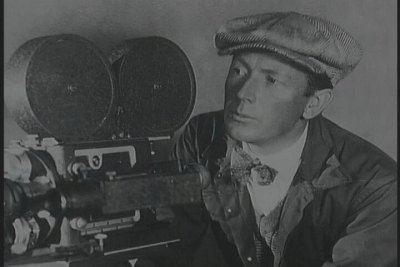 F. W. Murnau helped lay the groundwork for modern cinema. His desire to liberate the camera and have it move, his technical ability, and his visual sense made him one of the most impressive directors of the silent era.
F. W. Murnau helped lay the groundwork for modern cinema. His desire to liberate the camera and have it move, his technical ability, and his visual sense made him one of the most impressive directors of the silent era. The time between the world wars was a difficult one for Germany. The crushing peace treaty they signed ended WWI required Germany to make reparations to the French and British for the cost of the war. The German economy was in ruins. The German mark was virtually worthless. (In November of 1923 the exchange rate for the Mark was four and a half trillion to one against the dollar!)
One industry that still flourished in Germany was the film trade. It is easy to see why. With inflation running rampant, and the Mark devalued, anything that could be sold for foreign currency was in high demand. Movies were becoming more popular around the world, and Germany was able to supply the need, cranking out 500 films a year. Only Hollywood produced more.
The largest German movie studio was Universum Film AG or Ufa for short (pronounced OOH-fa.) Created during WWI by the German government to make propaganda films, it was still going strong after the war. Privatized in 1921 and run by Erich Pommer, the producer of the 1919 masterpiece Das Cabinet des Dr. Caligari, the studio had a strong group of directors (including Fritz Lang, and Ernst Lubitsch) a large amount of resources, and soon became a major force in international film.
It was into this climate that Friedrich Wilhelm Murnau joined the German film community in 1919. He had studied literature and art history at the University of Berlin and later in Heidelberg, planning to become a teacher. Murnau was performing in a school play when he caught the attention of the director Max Reinhardt. Murnau was invited to join Reinhardt's acting school, and he stayed there until the outbreak of WWI. During the war he was a fighter pilot reportedly surviving eight crashes without serious injury. He eventually crashed in Switzerland, where he stayed until the end of the war. Returning to Germany, he started directing and made about a dozen movies between 1919 and 1922, most, if not all, of these early films are lost. It was in 1922 that Murnau made his breakthrough movie that brought him international acclaim, Nosferatu.
Kino has released a boxed set of five of the great director's movies that includes his most powerful and famous films. This boxed set includes 1922's Nosferatu, The Last Laugh, Tarfutte, Faust, and his final film, Tabu.
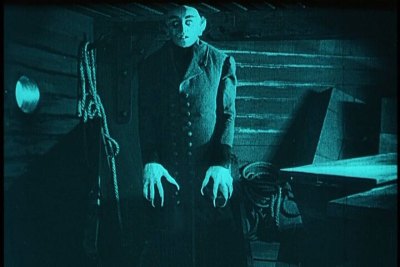 In 1922 F. W. Murnau burst onto the international film scene with his horror masterpiece, Nosferatu. Though Murnau's films had been noticed before this one, none of them had achieved the critical success as this study in terror.
In 1922 F. W. Murnau burst onto the international film scene with his horror masterpiece, Nosferatu. Though Murnau's films had been noticed before this one, none of them had achieved the critical success as this study in terror.
Most people familiar with silent films have heard the origins of this film. When the creators did not want to go to the expense of purchasing the right to Bram Stoker's Dracula, they changed the names and made it anyway. They did pare the novel down to its core essentials, but at its heart, it is still Stoker's Dracula.
Real estate agent Thomas Hutter (Gustav von Wangenheim,) is sent to the Carpathian Mountains to finalize the sale of an estate to Count Graf Orlok (Max Schreck.) Laughing off the locals warnings, Hutter travels to Orlok's castle, but soon stops laughing when he sees the eerie looking Count. After completing the sale, Orlok sees an image of Hutter's wife, Ellen (Greta Schröder) and departs for her town of Bremen by boat. When the boat arrives, all the crew are dead, and rats flee the ship. Orlok wants to feed on Ellen, but her husband realizes the danger she is in and is hurrying back to protect her.
This film is a masterpiece of horror and of German Expressionism filmmaking. The more often you see this film, the more amazing it gets. The low camera angles, sharp contrasts, and dreamlike atmosphere all come together to form a distortion of the real world. This distortion makes the movie oddly unsettling, and the introduction of Count Orlok greatly adds to the eeriness.
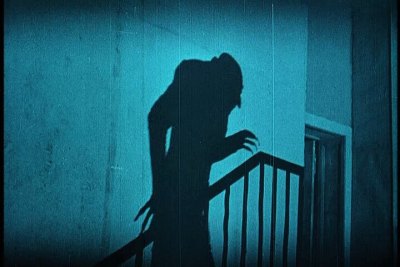 The acting was superb all around, but Max Schreck was simply amazing. His portrayal of Graf Orlok was both horrifying and intriguing. You couldn't look away from his odd appearance. This vampire was no suave, elegant gentleman like Bela Lugosi portrayed him. Schreck's character was a ghastly dead creature, more rat than man. The talon like finger, large deep set eyes and unnaturally long ears made him look inhuman. His acting accentuated the evil in his character that matched the decaying exterior. No one would ever play the lord of vampires so effectively again.
The acting was superb all around, but Max Schreck was simply amazing. His portrayal of Graf Orlok was both horrifying and intriguing. You couldn't look away from his odd appearance. This vampire was no suave, elegant gentleman like Bela Lugosi portrayed him. Schreck's character was a ghastly dead creature, more rat than man. The talon like finger, large deep set eyes and unnaturally long ears made him look inhuman. His acting accentuated the evil in his character that matched the decaying exterior. No one would ever play the lord of vampires so effectively again.
What this all boils down to is that this is a fantastic movie. It works on many levels, it is artistic, innovative and even beautiful. There are images in this movie that will stay with you long after the film is finished. Of all the adaptations of Dracula that would come after this, Nosferatu is still the best.
After the movie was released, Stoker's wife sued, and eventually won a court settlement that included the burning of all copies of the film. Luckily, there were prints that escaped the flame in other countries. It is ironic that Florence Stoker wanted the film destroyed, since many film historians note Nosferatu's popularity as a reason the stage play, and the later movie versions, were ever created. Thereby giving eternal life to her husband's greatest work.
The DVD:
Audio:
There are two audio tracks available on this disc, both presented in stereo. The default track contains music written by Donald Sosin with vocals by Joanna Seaton. The alternative track has music composed by Gerard Hourbette and Thierry Zaboitzeff, preformed by Art Zoid.
The problem with both these sound tracks is that they are absolutely horrible. I am amazed that Kino didn't come up with a better track to enjoy this movie by. The default track prominently features a pan flute, or similar instrument, in many of the movements. This music sounds cheap and inappropriate. To make matters worse, this track also includes the sounds of a woman gasping and moaning during some scenes. (Such as when Ellen dreams that her husband is in trouble.) These vocal sound like a bad dub job on a porno movie.
The other track is even worse, if you can believe that. The music, and I use the word loosely here, has a very heavy industrial sound mixed with new age minimalist sounds. there will be the sound of wind blowing through chimes, followed by loud metallic percussion like machines stamping out metal parts. It really wasn't musical at all.
I was deeply disappointed in both musical scores.
Video:
The video quality was very good for this film. I don't think I've ever seen it look better. That is not to say it is pristine, even when its age is taken into consideration. The negatives and many first print copies were destroyed due to Mrs. Stoker's legal suit. The only copies left in existence are somewhat removed from the camera negative. This version of the film is a transfer of the 1995 Bologna restoration. It has a lot of dust and specks and other print damage. There is some emulsion decomposition in a few scenes, and there are missing frames too. The contrast is not excellent, but it is very good, though the picture is darker than it should be. There is a good amount of detail present, and the picture if fairly sharp. It is easy to pick out folds in cloth and other details that are often missing. A nice copy, but not the definitive restoration I was hoping for. (That has not been done yet, probably due to the amount of time and money it would take to digitally remove all the scratches and imperfections.)
The Extras:
There are excerpts from several other Murnau films: Journey into Night, Haunted Castle, Phantom, The Last Laugh, Faust, and Tabu.
Kino provides a scene comparison of the dinner scene. They include an excerpt from the novel, the shooting script for Nosferatu, the filmed scene, and an audio excerpt from the Mercury Theater on the Air Radio show. The audio on the radio show was muddled and hard to understand.
Lastly, there is a photo gallery of production stills and magazine covers that featured the movie.
Final Thoughts:
Books have been written about this film and the German Expressionist movement. I could go on about the use of location shooting, frame composition, and the innovative use of montage, but that is not in the purview of this review. Suffice to say that this is an excellent film. The video quality, while not perfect, is very good with nice contrast and sharpness. Unfortunately the sound tracks both left a lot to be desired. This DVD is still highly Recommended, if you watch it with the sound muted.
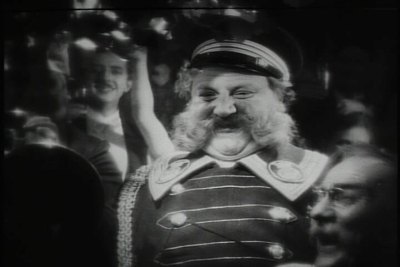 Two years after filming Nosferatu, F. W. Murnau made one of the most impressive films of the silent era, which helped lay the groundwork for modern cinema. In 1924's The Last Laugh (entitled Die Letzte Mann in German which translates to "The Last Man," a much more appropriate title in more ways than one) Murnau liberated the movie camera and sent it souring.
Two years after filming Nosferatu, F. W. Murnau made one of the most impressive films of the silent era, which helped lay the groundwork for modern cinema. In 1924's The Last Laugh (entitled Die Letzte Mann in German which translates to "The Last Man," a much more appropriate title in more ways than one) Murnau liberated the movie camera and sent it souring.
Most silent movies were shot with a camera on a stationary tripod. Cameras were still cranked by hand, and cranking at a constant speed was easiest to do that if the camera was stationary. So most films of the time did not have any camera movement. There was a occasional pan or tilt, but it was very rare to see anything that involved moving the position of the camera. Though Murnau was not the very first director to include moving shots in a film, he was the first to use them as frequently and to such effect. In this movie the camera isn't a silent observer, it is part of the story. The camera rolls through crowded rooms and out doors, it flies through the air and out of windows. Never before in cinema has camera work made the viewer feel so much a part of the action.
The innovative camera work was enough to make this movie a classic, but Murnau wasn't satisfied with that. He was also able to make The Last Laugh a truly silent film, a story told solely through the actors expressions and reactions. There is no dialog or intertitles (with one exception that I will discuss later.) The entire story, which is very easy to follow, is told through the actors performance of their craft.
The story is a simple yet powerful one. An old, unnamed doorman (Emil Jannings) at a posh hotel is proud of his position. He has a long regal coat with tassels and shiny buttons, and he takes his job very seriously and performs it with pride. He is admired by all of the people in the run down neighborhood where he lives because of his respectable job.
During a heavy rain one day, he takes in a heavy chest by himself rather than waiting for assistance to better serve the guest. He sits down for a moment to catch his breath afterwards, and the assistant manager sees him. The next day, when arrives at work, he finds someone else performing his duties. The assistant manager calls him in and informs him that he is too old to be the door man, but if he would like to stay employed, he can be the attendant in the men's washroom. He is stripped of his coat.
Jannings is crushed. To have had such a respected position and then falling so low is more than he can face. He can not bear to let the others from his neighborhood know, so he sneaks back at night and steals his coat back. After this, he spends his days being humiliated in the washroom, and changes into his coat after work to go home. But he can not keep this pretense up for long.
In order to fully discuss this film, and the only intertitle card, more of the plot than I would like has to be revealed. If you'd rather not find out what happens, skip down to the "End of Spoiler" notation.
Spoiler:
It is eventually found out that the doorman has lost his position. When it is revealed, he becomes the laughing stock of his block and leaves. Having no where to go, the man hunches over in a corner, his only friend the night watchman who covers him with an old cloak. At this point, the only title card is the movie is displayed: "Here the story should really end, for, in real life, the forlorn old man would have little to look forward to but death. The author took pity on him and has provided a quite improbable epilogue."
There is then a newspaper clipping stating that a local man has inherited a fortune. We see the doorman in the hotel's restaurant stuffing himself on fine food and wine. The night watchman, dressed in fine clothes, joins him, and the two eat enjoy living a life of luxury while the hotel staff who had treated the doorman so poorly look on in envy.
End of Spoiler
Again, as with Murnau's other German films, the cast was impeccable. The whole movie clearly rested on the shoulders of Emil Jannings who is able to breath life into the character of the doorman. You can feel his crushing defeat as the coat is taken off of him. The fact that the entire plot is very easy to follow without any dialog is a testament to Jannings' ability as an actor.
Of course the startling camera work and cinematography needs to be mentioned. The movie was filmed by one of the greatest German cinematographers of the silent era, Karl Freund. Freund would go on to film such classic as Metropolis, the fantastic All Quiet on the Western Front (1930,) Tod Browning's Dracula (1931) and many more. He would spend the end of his career as the head cinematographer on the I Love Lucy TV show where he developed the three camera system for recording TV shows that is still in use today. His ability really shines through in this film. He came up with many of the unique techniques used to film movie, including being suspended by a rope and pulley system and being rolled around in a wheel chair to obtain the tracking shot at the beginning of the movie. A truly beautiful film.
The Last Laugh is a very powerful movie, that transcends its melodramatic origins, and becomes not only a moving story, but art as well.
The DVD:
Audio:
The sound track was provided by a the Olympic Chamber Orchestra conducted by Timothy Brock who composed the score. The stereo mix was clear and free of hiss. The full orchestra added a lot to the enjoyment of this film. The score was very appropriate, nicely accenting the scenes on the screen, without being overpowering. Just what I want in a silent film score.
Video:
The video quality for this film was very good, with only very minor print damage. Some of the bright highlights were a little too bright, resulting in some loss of detail but nothing too damaging. The image is a little soft overall, but not overly so, and could have been shot that way, though my guess is that it wasn't. A very nice looking film, with only minor flaws.
The Extras:
This disc contains a photo gallery and the original German intertitle cards for the caption near the end as well as the newspaper clipping.
Final Thoughts:
This simple tale of a man whose identity and self worth were measured by his job is as strong today as it was when it was filmed in 1924. Jannings is an extremely talented actor, and this is one of his best roles. (He would win the very first Best Actor Academy Award in 1929 for his performances in The Way of All Flesh and The Last Command.) With this film Murnau created a masterpiece of international cinema, silent or otherwise. Highly recommended.
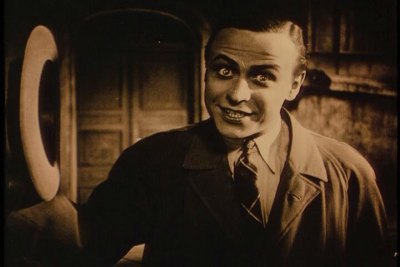 After the great success of The Last Laugh, F. W. Murnau wanted to adapt Goethe's story of Faust to the silver screen with Emil Jannings in the role of Mephisto. But Jannings was under contract to act in Tartuffe. Studio head Erich Pommer asked Murnau to direct the film while he was waiting for Janning's schedule to free up.
After the great success of The Last Laugh, F. W. Murnau wanted to adapt Goethe's story of Faust to the silver screen with Emil Jannings in the role of Mephisto. But Jannings was under contract to act in Tartuffe. Studio head Erich Pommer asked Murnau to direct the film while he was waiting for Janning's schedule to free up. Tartuffe is based on a play by Moliere, to which writer Carl Mayer (who also penned The Cabinet of Dr. Caligari as well as The Last Laugh) added a framing device to make the movie more modern.
An old man (Hermann Picha) is ill and being tended to by his housekeeper (Rosa Valetti.) She is slowly poisoning her charge, and has convinced him that his only heir, a grandson (André Mattoni,) is living a life of sin as an actor. The old man disinherits the grandson and leaves his fortune to the maid. When the grandson comes to visit, he is thrown out. As he walks from the house, he walks up to the camera and says "You who witnessed this scene may rest assured that I shall not give up without a struggle."
Applying a fake beard and wig, the young actor returns as a traveling cinema projectionist. He flatters the housekeeper into inviting him in, and proceeds to show the story of Tartuffe.
In this movie within a movie, a rich businessman Herr Orgon (Werner Krauss,) returns from a long business trip to his wife Elmire (Lil Dagover.) Orgon has changed though. He refuses to kiss his wife, saying that his friend Tartuffe (Emil Jannings) considers kissing a sin. He has the servants discard the painting and luxuries in a guest room to make it ready for Tartuffe's arrival, and then fires all of them save one maid (Lucie Höflich.) Tartuffe arrives, and is waited on hand and foot by Orgon, who regards the strange man as a saint. Spending all his time reading while pacing the house, Tartuffe notices Elmire, and starts lusting after her. Elmire discovers that her husband has been slowly giving away his fortune to this religious man, and hatches a plan to expose his hypocrisy. Hiding her husband behind some curtains, she tries to seduce Tartuffe. Just as he is about to fall into her trap, Tartuffe notices Orgon's reflection in a silver decanter and leaves, saying that he will pray for Elmire. Orgon is now more convinced than ever of his friends holiness and plans to leave his entire estate to him. Can Elmire find a way to make her husband see Tartuffe for what he really is, and if so, will that have any effect on the old man and housekeeper watching this movie?
This is a minor work of Murnau's, completed in just six weeks. There is very little of the amazing camera work that was justifiably lauded in The Last Laugh. It was a very minimalist work, with everything pared down to the essentials. The sets were sparse, as was the number of actors, even Moliere's play had two acts and many characters removed from it. There are several scenes where action is implied rather than shown. After Orgon's return home and refusal to kiss his wife, he goes into a room and closes the door. Elmire enters moments later and the camera stays on the closed door. Seconds later Elmire leaves the room looking dejected. Murnau doesn't need to show the wife being rejected a second time, it is evident.
One aspect that was interesting was the way the frame story and the play were filmed. Each of the segments had a very different look. The framing section was filmed very realistically manner, with all the characters in sharp focus. The internal movie, was filmed in a much more traditional style, in soft focus, and the film was tinted. This contrast works well to differentiate the two story lines.
Clocking in at 63 minutes, Tartuffe is an interesting footnote in Murnau's career, but not one of the great works that the director is know for.
The DVD:
Audio:
There is a two channel mono piano score by Javier Perez De Azpeitia accompanying the film. The score is well suited to the action on screen and does a good job of matching the mood. There are no other sound effects added. The audio quality is very good. There was no hiss of distortion.
Video:
There were three different master prints to Tartuffe, a domestic German release, one for the United States, and a third for the rest of the world. This DVD contains a restored version of the American print that is held in the Library of Congress. The restoration team did a good job. They were wise and left the original intertitles intact. I hate when new title cards are inserted, there is always a glaring difference between the pristine new titles and the old movie print. The picture was very clear, had an excellent amount of detail, and the contrast was very good. I didn't notice any missing frames, something that occurs in almost all silent movies due to splices. I assume that this print wasn't screened very often.
It wasn't a prefect print though. There was a good amount of speckling, scratches, and dirt on the print, which was most evident in the dark scenes. Thought the contrast was good overall, in some scenes the white highlights were washed out, leading to a loss of detail. Even with these flaws, a very good looking print.
The Extras:
In addition to the film itself, this DVD has an interesting 35 minute documentary The Way to Murnau. This film looks at his life and films with quotes from friends and relatives and clips from his most important works. Though it does gloss over some areas, it is a good overview of his life and work, and a welcome addition to this disc.
Final Thoughts:
Tartuffe is not a major film, but one that is worth watching. When compared to the films he did both before and after this one, you can see that Murnau's heart wasn't really into this production. The restoration was very good, and the movie is very easy on the eyes because of it. After having seen more than my share of badly preserved prints being transformed to home video, it is a nice to see high quality material being released more often. Taking into account that a mediocre Murnau film is still better than most films, and the excellent documentary included as a bonus, this is easy to give this DVD a recommended rating.
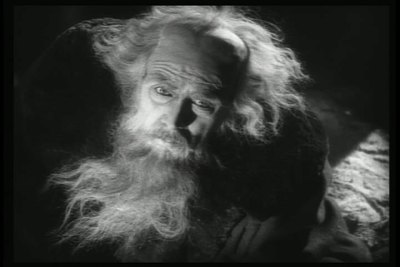 After the international successes of his films Nosferatu and The Last Laugh, Ufa studios gave F. W. Murnau carte blanche to bring to the screen his version of Goethe's classic tale Faust. Here an artist had a huge budget and the power of a large studio behind him. He created a technical marvel and remarkable film.
After the international successes of his films Nosferatu and The Last Laugh, Ufa studios gave F. W. Murnau carte blanche to bring to the screen his version of Goethe's classic tale Faust. Here an artist had a huge budget and the power of a large studio behind him. He created a technical marvel and remarkable film.
War, Famine and Pestilence ride across the sky. The Devil (Emil Jannings) looks on as they spread their disaster, his large wings expanding to engulf the world. But rays of light shine out from behind the Devil. An Angel of the Lord appears and reminds Satan that he does not have dominion over the Earth. The Devil claims that the Earth is his since he can corrupt any one he wants to. The Angel points out Faust (Gösta Ekman,) and asks if he is corruptible. The Devil and the Angel make a wager: If the Devil can corrupt Faust, he will gain control over the Earth, if not, he must leave the world alone.
The Devil starts by casting a plague on Faust's village. In a few day, half the people have died. Faust prays for an entire day and night, but the medicine he has still doesn't help cure the stricken. In a moment of rage at his uselessness, Faust throws his books into the fire. While one is burning, it opens up and Faust reads an incantation for summoning Mephisto and gaining earthly powers. He pulls the book from the fire.
The next evening he goes out to the crossroads and summons Mephisto. Startled and frightened when he appears, Faust runs home, only to find the Devil waiting there for him. Mephisto tempts him, and Faust finally concedes to renounce God for one day, if the Devil will do his bidding. They sign in blood. The first thing Faust does with his new found powers is to cure the people in his village. He is successful until a girl arrives clutching a cross. He cannot get past the crucifix and the people realizes that his power comes from the Devil and start to stone him.
He escapes to his room where the devil tempts him once again, this time with youth. The old man can not resist this offer, and is transformed into a charming young man. Mephisto then takes Faust to a beautiful princess and helps him seduce her. But just as he is getting ready to join her in her bed, his time runs out. Faust can not stand the thought of becoming old again, so he agrees to make their deal permanent. With the Devil always one step ahead of him, is there anyway for Faust to save his soul and all of humanity with it?
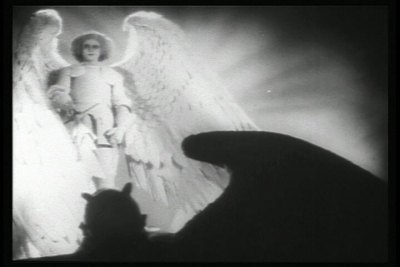 This was a fun movie. The effects were great for the time, and still impress. It is interesting to note that Murnau filmed this movie entirely on sound stages, eschewing location shoots that he used so effectively in Nosferatu (and would use again when filming Tabu.) He wanted the control over all aspects of the film that a studio shoot would give him, and he used it to the fullest advantage. The intricate special effects and camera tricks he was able to create make the film a masterpiece. The camera works was exceptional, with many shots blocked out to make them look like paintings. The smoke and flowing costumes all added to the effect.
This was a fun movie. The effects were great for the time, and still impress. It is interesting to note that Murnau filmed this movie entirely on sound stages, eschewing location shoots that he used so effectively in Nosferatu (and would use again when filming Tabu.) He wanted the control over all aspects of the film that a studio shoot would give him, and he used it to the fullest advantage. The intricate special effects and camera tricks he was able to create make the film a masterpiece. The camera works was exceptional, with many shots blocked out to make them look like paintings. The smoke and flowing costumes all added to the effect.
Murnau liberated the camera in this movie too, like he did in The Last Laugh (though not to the extent he did in the earlier picture.) He controlled the film's space, and filled it with movement and detail. A gorgeous film to watch.
The acting was first class all around. Lillian Gish was originally cast as Gretchen, but wouldn't do the movie unless her cameraman, Charles Rosher, could shoot it. Ufa refused to this demand, and Camilla Horn, an unknown German actress was given the part. She would go on and have a successful career in movies and TV that lasted well into the 1980's. Gösta Ekman did a wonderful job as both the young and old Faust. His movements and gestures when he was old were very realistic and convincing. But the star of the show was Emil Jannings as Mephisto. He played the role with the right mix of evilness and humor (it really looked like he was enjoying putting poor Faust through the ringer.) Truly a masterpiece of early film art.
The DVD:
Audio:
The sound track was provided by a the Olympic Chamber Orchestra conducted by Timothy Brock who composed the score. As with the score that Brock composed for The Last Laugh, this composition is wonderful. It is full and bold, and the music emphasized the emotions playing out on the screen. The stereo mix was very good too, with no noticeable hiss. A clear and clean sound track that matches the movie very well. A great choice.
Video:
The video was excellent, amazing for a 75 year old film. The print was taken from a restored 35 mm archive print, that has very good contrast and definition. There are a wide variety of gray tones and details are visible even in light shadows. The picture was fairly soft, and there are some scratches and dirt on the print, but this is a minor problem with this film. The few spots where emulsion damage or other major print defects occur are very rare, but there are some. A great looking silent film.
The Extras:
The only extra is a photo gallery with a selection of production stills and behind the scene photographs.
Final Thoughts:
This was Murnau's last film in Germany. After filming Faust, Murnau left Ufa and went to Hollywood. This artistic yet attention-grabbing film was a fine ending to his German period. The special effects were awe inspiring for the time, and the morality play was interesting. The picture on this DVD is outstanding for a film this old, and the musical sound track was one of the best I've heard in a while. One of Murnau's great films on a great DVD. Highly Recommended.
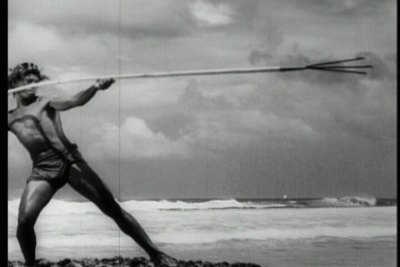 When Murnau arrived in Hollywood under contract with Fox Studios, he went to work on Sunrise, he was left to his own devices, for the most part, and the film went on to win three Oscars in the 1929 Academy Awards. He then did two other films for Fox, with an increasingly larger amount of studio input. Input that he neither needed nor wanted. After filming was completed, it was announced that both of these films, Four Devils and City Girl, were going to have scenes reshot to add sound. The reshoots to be directed by a sound engineer, with no input from Murnau. This was all he could take, and he bought out his contract.
When Murnau arrived in Hollywood under contract with Fox Studios, he went to work on Sunrise, he was left to his own devices, for the most part, and the film went on to win three Oscars in the 1929 Academy Awards. He then did two other films for Fox, with an increasingly larger amount of studio input. Input that he neither needed nor wanted. After filming was completed, it was announced that both of these films, Four Devils and City Girl, were going to have scenes reshot to add sound. The reshoots to be directed by a sound engineer, with no input from Murnau. This was all he could take, and he bought out his contract.
Murnau then spent some time learning to sail, and bought a 65 foot yacht. He was still interested in film though, but didn't want the studio to be able to dictate to him how to make his films. So he formed a film production company with documentary film maker Robert J. Flaherty (Nanook of the North, Man of Aran,) both filmmakers being equal partners. The pair decided to film a movie in Tahiti. They would move to the island, spend some time living there, and developed a story involving the native people. They singed a deal with a company Colorart to back the film and set off for the south seas.
No sooner had they arrived then problems began. Colorart had not sent the film stock and money that was promised. After months of cables back and forth, it was decided that Murnau would finance the film himself.
The two worked well together for a time. They outlined a basic plot and worked on the story. They found native actors to fill the major roles. But there was tension. With Murnau bankrolling the film with his own savings, they were no longer equal. Their styles were very different. As where Murnau was trained in the studio system making dramas, Flaherty was self taught and documentaries. Flaherty's style was to shoot miles of film and then piece something together in the editing room. The frugal Murnau did not like that at all. Eventually things came to a head, and Murnau bought out Flaherty at the latter's request.
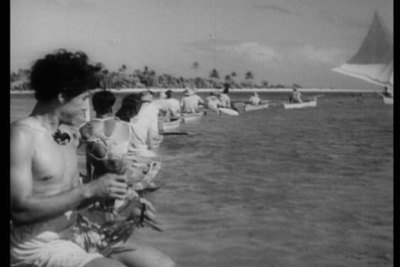 The two were able to create a story involving the native culture, but not a documentary. The cultural and religious beliefs that they illustrated were no longer in practice when the movie was made, but they had only died out recently, and there were still people who remembered the old ways.
The two were able to create a story involving the native culture, but not a documentary. The cultural and religious beliefs that they illustrated were no longer in practice when the movie was made, but they had only died out recently, and there were still people who remembered the old ways.
The story centers around a young couple, Reri and her boyfriend Matahi. They are in love but something happens that threatens their future. A schooner sails into the harbor carrying Hitu, the representative of the "king of all the islands." He brings news that the sacred maiden has died, and that a new one must be chosen. The king has selected Reri because of her beauty and purity. From that day forth, no man may touch her or think of her with lust. She is Tabu.
That night Matahi sneaks aboard the ship, and steals Reri away. They run to an island controlled by the white man, where the tribal will not be able to harm them. But they didn't count on being trapped by the new customs that they encounter there.
This film is woven together very gracefully. The relationship between the couple being trapped by old beliefs and them being trapped by the monetary society that they enter was well done and not heavy handed. The movie could have easily digressing into sappy melodrama, but it doesn't.
While lacking the resources of a large studio picture this is still a masterful film. There are no elaborate special effects or interesting camera movement that had populated his earlier works, but Murnau proved that he didn't need those to make an interesting picture. The scenery is a beautiful backdrop, and responsible for some lovely shots, but the editing really tells this story well.
The DVD:
Audio:
The audio for this movie is a musical track in mono. There is a lot of hiss present, and the sound is rather flat and thin. The track is rather old, and not a lot has been done to it. It is acceptable, but not by much.
Video:
The video for this DVD was taken from a preservation negative. The quality was pretty good overall. There was some print damage, as you will find in any film this old, but they were minor. There was very little speckling and dirt on the print, but the picture was very soft and slightly blurry. There are a couple of instances with unstable frames also. A nice, if somewhat too soft, picture.
The Extras:
There is a good number of extras on this disc that really enhance the package.
Commentary: Professor Janet Bergstrom from UCLA provides a full length commentary for the film. Her comments were very informative and interesting. She talked about the history of the production, the troubles that occurred between Murnau and Flaherty, and gave a brief biographies of the filmmakers. As the film went on, she had less background to give, and her scene specific comments, while welcome, restated what was happening on screen a little to much. Aside from that minor criticism, a quality commentary.
Outtakes: 23 minutes of unused footage from the film, with narration by Janet Bergstrom. She talked more in detail about problems Murnau and Flaherty had with the company that put up the money for the film, Colorart.
Reri in New York: After the success of Tabu, the young actress who started in the film found herself an international star. She went to the states, and preformed in the 1931 Ziegfeld Follies. This film footage looks like it was from a screen test that she did while in New York. She is older, and this footage show her walking through the park, and feeding birds. The 3 ½ minute reel is narrated by Janet Bergstrom who gives details of Reri's life after the film. An interesting commentary and film reel.
In addition to these features, there is also a theatrical trailer, still gallery with many production and on the scene photos, and script excepts in .pdf format that can be viewed on a computer with a DVD-Rom drive.
Final Thoughts:
Some have called Tabu Murnau's best work. While I feel that this last film is excellent, I think some of his previous work was stronger. Tabu does illustrate what a powerful filmmaker Murnau was even without a large studio or big budget. This uncomplicated film, almost archetypical in its simplicity, is still moving and engrossing. It is one of the last great silent movies (along with Chaplin's City Lights.) The fine print, though a little too soft, makes this a great addition to any silent film collection. Recommended.
Concluding Thoughts:
F. W. Murnau died on March 11, 1931 only weeks before the premier of Tabu. His Phillipino houseboy was driving him when he lost control of the vehicle and plunged off a cliff.
Murnau's contribution to modern cinema can't be overstated. His innovative camera movement, his contribution to German Expressionism, and amazing visual sense were the building block of modern cinema. The French director and film critic Eric Rohmer has called Murnau the best director that ever lived.
Murnau was not a man who could be seduced by money, or he would have never left Hollywood. Nor was he willing to compromise on his artistic vision. Ironically, these attributes that caused him much trouble during his life are the reason we remember him today. Those traits are what pushed him to create the masterpieces that he did.
This set of his films includes Murnau's best work. Only Sunrise is missing (the rights to that are still owned by Fox.) It is a rare treat to be able to have so many important and influential films in one set. This box is an excellent addition to any film lover's library. Highly recommended.








